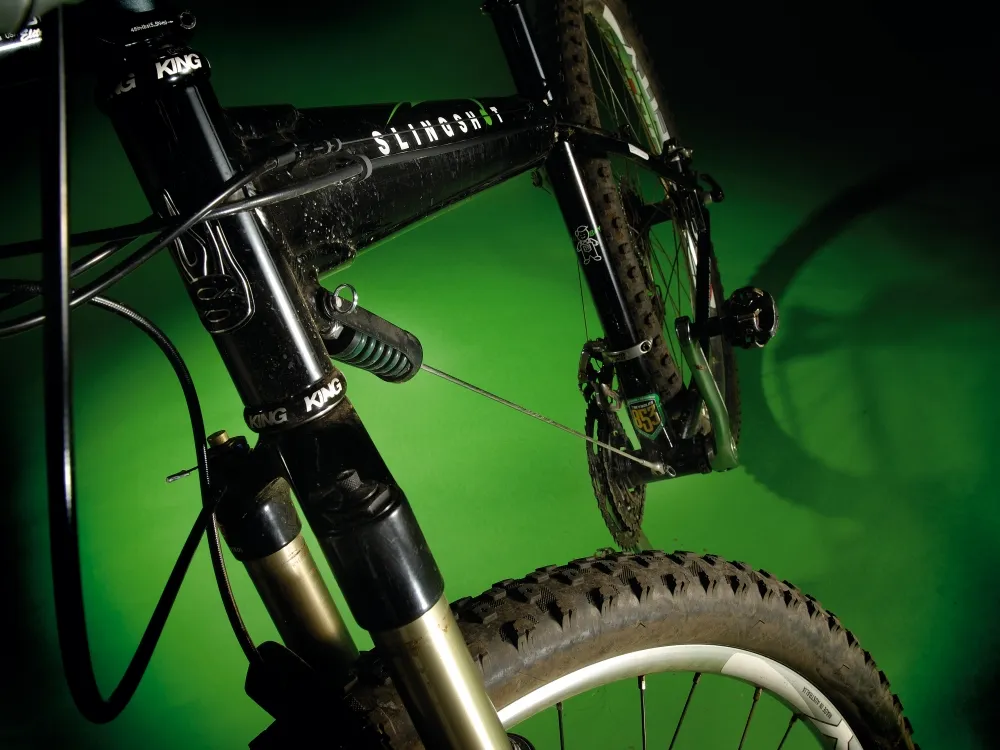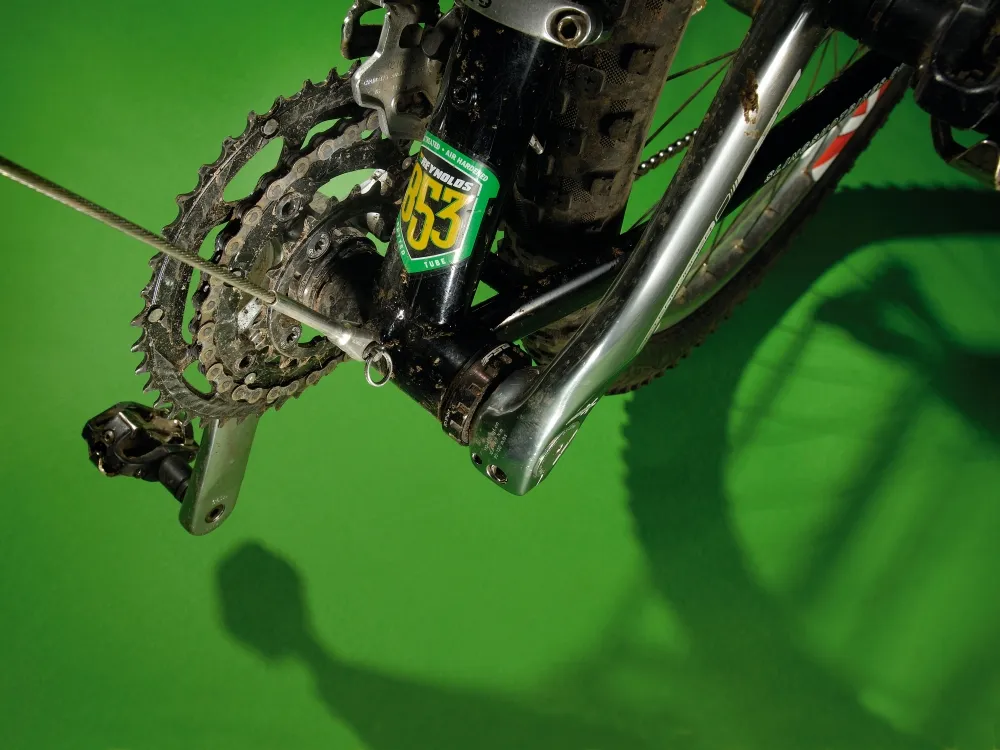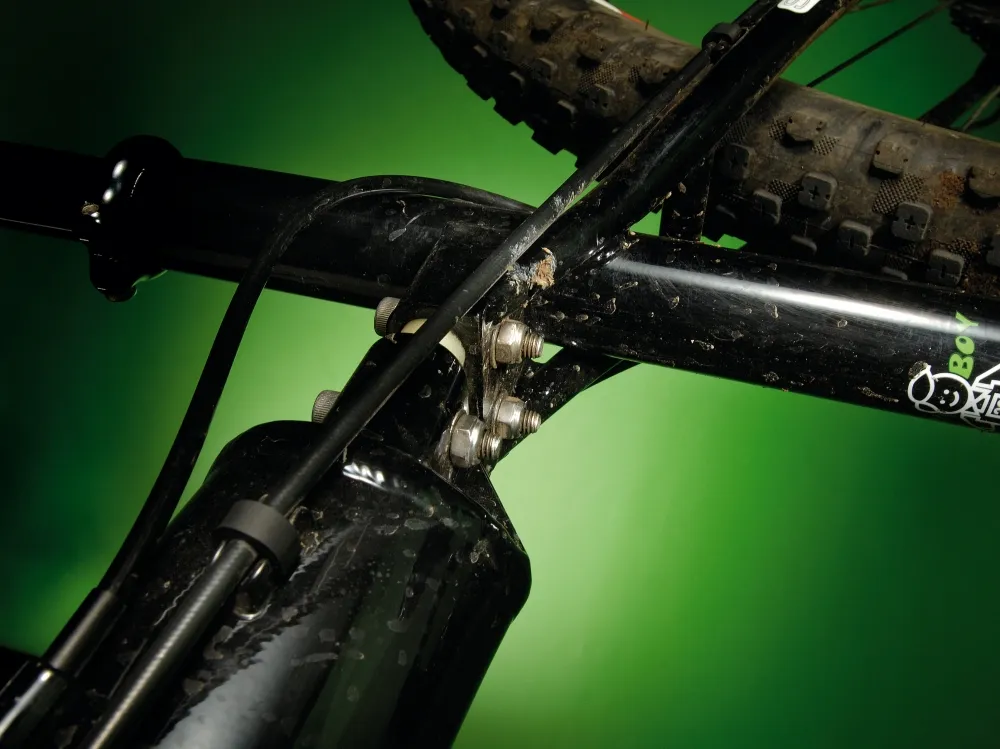Forget carbon and 6-inch suspension, Slingshot is using old technologies to produce a modern-day 'soft-tail' that doesn't bother with down tubes
A look through the last century of bicycle design will reveal that adding suspension to a bike to smooth its path is anything but a new idea. From John Dunlop's first air-filled tyres to long slung-hammock seats, rubber bumpers, floating axle hubs, hinged stems, gas, oil, and coil springs, almost everything has been tried and tested in far too many ways to accurately recall here. Even ridiculed and rejected ideas from decades ago tend to resurface with a twist from time to time.
Which brings us neatly to the Slingshot Farmboy. Whoever would have thought that replacing a frame's down tube with a spring-loaded stainless steel cable and adding a flexing fibreglass 'dog bone' hinge at the back end of the top tube might tame the trail better than many other hardtails and nearly as well as some short travel soft-tails? But it does, albeit with a couple of quirky mannerisms that you'll either hate or grow to love.
Why & how?
Slingshot has been around since the early '80s, but the inspiration came about ten years before. Mark Groendal, inventor of the original Slingshot, discovered that a broken down tube on his mini motorbike created a far smoother ride.
Flex, as suspension, was making rough terrain easier to ride. He set about making the first Slingshot bike frame, a BMX. But this wasn't only about taming the bumps. The idea was that by replacing the down tube with a sprung cable you would also return energy lost during the pedal stroke: the strongest part of the pedal stroke would compress the spring and shorten the frame, while the weakest part of the stroke would allow the spring and frame to extend, and the rear wheel to accelerate. This effect, taken to its logical extreme, creates a sort of inch-worming effect. But it doesn't feel extreme. The movement is subtle and controlled by the (bolted-in-place and replaceable) flexible fibreglass plate at the seat tube end of the down tube.
Slingshot's first MTB, released in 1985, was a much weirder looking affair than this. It featured a quadruple top tube and two cables instead of a down tube. The new Farmboy, with its massively reinforced alu top tube, four-bolt-fixed fibreglass hinge and Reynolds 853 steel extended seat tube, looks almost conventional in comparison.
The Farmboy isn't Slingshot's first big wheeler. Four years ago, a while before the big wheeler bandwagon rolled into town, it launched its Bigshot. As with the Farmboy, it came with 700c road wheels and you could fit either road or MTB tyres, although the choice of MTB tyres for big wheelers was very limited back then. With the slight flex of the 'Sling Power' ride and the lack of 29er suspension forks in those days, a rigid fork was the norm. Our Farmboy came fitted with an 80mm travel RockShox Reba fork, the most popular 29er fork these days. The frame has cantilever brake bosses, as well as a disc brake bracket, for those who still prefer rigid forks and V-brakes.
Performance
Despite having one less tube, Slingshots aren't light. The 18in Farmboy frame weighs in at about 6lb and, even with its selection of fairly light componentry, a tough wide-rimmed Velocity wheelset helps to hike the complete bike weight up to just under 29lb. So it has to be asked, is the Slingshot's unique design worth its 2lb or so of additional frame weight over and above a conventional hardtail? Let's assess the pros and cons.
When you set off on the Slingshot, you expect it to feel different to other bikes. But it doesn't, at least not as much as you'd expect it to, until you start hitting bumps. Initially it just feels like so many other big wheelers - acceleration and climbing is a bit slower than on 26ers but the rolling momentum of the bigger wheels is better. But as bumps and dips commence, you immediately notice that the wheels roll across them slightly more smoothly than 26in wheels. Also, the longer contact patches of the tyres add some traction. All of this adds confidence and helps you to maintain that extra rolling momentum through the corners and on bumpy descents. In short, the ride on the Slingshot is less choppy than on a 26er.
But, and this is where things get a little more complex, the 'Sling Power' effect adds another dimension to the ride. Some riders liked it, others were unconvinced. It's not until you watch someone riding bumpy terrain on the bike that you realise just how much the cable and spring are working, although on the bike you'll sometimes hear a disconcerting metallic 'clunk' as the undamped spring and cable recoil after big bumps. You'll notice the ride-softening effect of the mid-frame 'splaying' over bumps and you'll also feel a split-second-delay kick through the saddle. It's not as harsh as on most rigid-framed hardtails but it takes a while to get used to the fact that you feel the edges of bumps just after you hit them. With a Cane Creek Thudbuster seat post fitted the recoil was barely noticable, but that's adding another pound to the bike weight.
So how about the 'power storing' effect of bumps and pedalling on the way the bike performs? Slingshot says, "Every bump is a boost." Well, we did notice it, especially on steep bumpy climbs where you'll quickly learn to use the slight inch-worming effect to create mini surges. You can effectively load the spring on bumps and on the most powerful part of your pedal stroke and then use the spring release/recoil to nudge the bike forward a little. It's only a slight advantage, but we quickly learned to use it and got up a few technical grunter climbs that had often beaten us on other bikes. Elsewhere any positive effects seemed to be neutralised by the other stuff happening on the trail.
The verdict
The Slingshot Farmboy will appeal to those who want a bike that stands out from the crowd. The 29in wheels make for a smooth ride while the sprung mid-frame softens blows. You learn to use the recoil action of the sprung cable to nudge the bike forward over difficult technical terrain, but it takes a while to get used to the ride feel, and we're still not convinced that the extra weight in the frame produces enough performance advantages. However, it's fun to ride, the overall handling performance is good and learning to get the best out of the 'Sling Power' is an interesting process. We also add this recommendation: go for a soft spring. We found it made for a much more pleasing ride than the hardest one.




